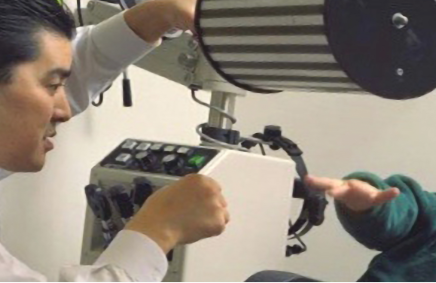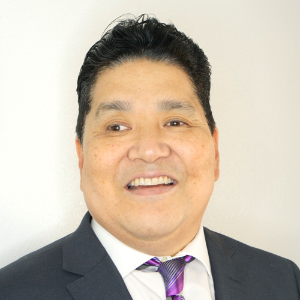A doctor’s diagnosis: cone-rod dystrophy
July 25, 2018
“Dr. Bill” Takeshita, renowned Los Angeles optometrist, was intimately familiar with the dramatic way that vision loss and blindness could change a life. He just never thought it would be his own.

“Dr. Bill” as his patients call him, working with a child at the Center for the Partially Sighted in Santa Monica, California.
Dr. Bill Takeshita had everything he’d ever wanted. He was the first person in his family to go to college, hoping to bring better vision to children with vision loss. After receiving his Doctor of Optometry degree, he helped develop the first pediatric low-vision center in Los Angeles, soon establishing himself as a world-renowned leader in the field of pediatric optometry. At home, life was good, too. He and his wife had a happy marriage and two beautiful children.
Then, in 2004, after 13 years of unbridled professional success, life took a left turn. “I was examining a little girl,” says Takeshita, “and I saw a spot in her eye. It was a kind of spot that I’d never seen in anyone’s eye before.” Takeshita moved his eye to look at a different part of the girl’s retina and saw that the spot moved as well. “That’s when I realized, ‘Hey, that’s not a spot in her eye. That’s a blind spot in my eye!’”
His colleagues at the UCLA Jules Stein Eye Institute ran Takeshita through a series of tests and diagnosed him with cone-rod dystrophy (CRD), a genetic (or inherited) retinal disease bound to end in blindness. For one of the country’s leading optometrists, it was a stunning turn of events. The condition progressed until his other eye was also affected, and within a few months the disease forced him to leave his practice, his dreams, and his life’s work.
Not being able to do what I loved to do—not being able to help people any longer—I really felt I was worthless.”
Vision loss and depression
Takeshita morphed from confident, thriving chief optometrist at the Center for the Partially Sighted in Santa Monica, California to a self-exiled recluse. Embarrassed that vision loss had toppled his career, he changed all of his phone numbers hoping to avoid condolence calls and the need to talk about his condition. “Not being able to do what I loved to do—not being able to help people any longer—I really felt I was worthless,” he says.
His spiral into grief, depression, and bitterness drove him to hit rock bottom in his life. Finally, thanks to a little tough love from his brother and the stalwart support of his wife, June, he realized that he had control over only one thing: his own attitude. “For years, I had been telling my patients how they could learn to read and write braille; how they could learn to walk with a cane; how they could use a computer that talks,” he says. “And I said, ‘You know what? I better start doing these things because I look like a hypocrite if I tell my patients these things and I don’t do them myself.”
That’s when Bill Takeshita began to reach back out to the world. He asked his former colleagues and even some of his former patients to teach him the very same skills he’d once recommended to his low-vision and blind clients. He made coffee in the morning for his wife. He made breakfast for his kids. In a short time, his world began to change. He began to feel like himself again—and once again he had dreams and goals.
Understanding the importance of genetic testing
Takeshita’s journey into complete blindness happened over the course of six years, from 2003 to 2009. During that time, he learned to accept his condition and to navigate successfully in the world. He reentered family life with gusto, embracing all that he had rejected when specialists told him he had CRD. Once he regained confidence, he began speaking at events, sharing his story and praising the life-changing programs available to anyone with vision loss.
He also kept a close eye on the ever-changing landscape of retinal research along with the medical advances being made in the potential treatment of inherited retinal diseases like CRD. Since no one else in Takeshita’s family had ever been diagnosed with genetic vision loss, he suspected that his case of cone-rod dystrophy was the result of a spontaneous genetic mutation.
When Takeshita realized that genetic testing might provide important information about his disease and help determine whether he was a candidate for clinical trials studying potential treatments for IRDs, he asked his doctor to order a test. “I had heard from a retinal specialist that there were studies I might be able to benefit from. My hope was that I might be able to participate in those studies,” he says. While he wasn’t eligible for any clinical trials at the time of testing, Bill Takeshita is not one to give up. He continues to keep abreast of the rapid advances being made in retinal science—and waits.
Life reimagined after vision loss
Meanwhile, his professional career is once again booming. Currently, Takeshita is a consultant for the Braille Institute of America; he also serves as faculty at the MB Ketchum University College of Optometry and lectures throughout the country on vision development, vision and learning, adaptive technology, and vision rehabilitation.
Although he may no longer be a practicing optometrist serving patients from all over the world, Takeshita says he’s come to realize that his real value is measured by the hurdles he’s overcome and the ghosts he faced down during the darkness that followed his diagnosis. “My blindness has made me a better doctor because I understand what the patients are going through. It’s made me a better professor because I can now teach my student doctors how they might respond or react to their patients. But most importantly, my blindness has made me a better person.”
Pediatric optometrist Bill Takeshita recommends parents of young children with low vision use vision stimulation activities to engage the visual cortex of the brain.
He suggests that they:
- Ensure appropriate lighting in the home
- Paint the walls and add decorations to create contrast
- Provide big toys with plenty of contrast (think Mickey Mouse)
- Use bowls and plates with big stripes or checkerboard patterns for contrast

Dr. Bill Takeshita
Dr. Bill Takeshita is an optometrist specializing in low vision. He is a consultant for the Braille Institute of America and serves as faculty at the MB Ketchum University College of Optometry. His podcast, “Low Vision Technology,” is available on iTunes.
Sign up to find out when we add new stories to the site.
